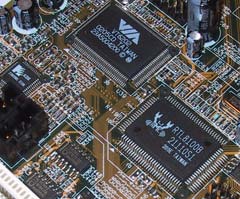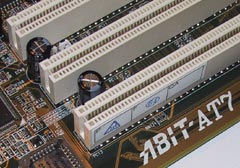VIA KT333 Motherboard Roundup - June 2002
by Anand Lal Shimpi on June 13, 2002 5:41 AM EST- Posted in
- Motherboards
ABIT AT7
|
Motherboard Specifications |
|
|
CPU
Interface
|
Socket-462
|
|
Chipset
|
VIA
KT333 North Bridge
VIA VT8233A South Bridge |
|
Bus
Speeds
|
100
- 250MHz (in 1MHz increments)
|
|
Core
Voltages Supported
|
1.100V
- 1.850V (in 0.025V increments)
|
|
I/O
Voltages Supported
|
3.5V/3.65V
|
|
DRAM
Voltages Supported
|
2.55V/2.65V/2.75V/2.85V
|
|
Memory
Slots
|
4
184-pin DDR DIMM Slots
|
|
Expansion
Slots
|
1
AGP Slot
3 PCI Slots |
|
Onboard
RAID
|
HighPoint
HPT374
|
|
Onboard
USB 2.0/IEEE-1394
|
VIA
VT6202 (4 USB 2.0 ports)/TI 21CN00T (2 Firewire ports)
|
|
Onboard
LAN
|
Realtek
RTL8100B
|
|
Onboard
Audio
|
Avance
Logic ALC650 - 6 Channel
|
If the KX7-333 was what we've come to expect from ABIT, their other KT333 board is definitely a curve ball if we've ever seen one. The area around the CPU and memory slots remains unchanged from the KX7-333; it's everything above and to the left of that area that sets the AT7 apart from the competition.
The AT7 is a member of ABIT's new MAX line of motherboards which are marketed as being the first true "legacy free" solutions on the market. The term legacy free means a lack of any serial, parallel or PS/2 ports on the motherboard; instead ABIT has outfitted the AT7 with no less than 6 USB ports and 2 Firewire ports on-board. As if that weren't enough, ABIT also provides two more USB headers through an external bracket that occupies a slot cutout in the back of your case.
Driving all of these USB ports is of course the VIA 8233A South Bridge, which is good for 6 USB 1.1 ports, but the VIA VT6202 controller is also present on-board to bring USB 2.0 support to the AT7. All but two of the USB ports on the board are driven by VIA's USB 2.0 controller.

The two on-board IEEE-1394 (Firewire) ports are driven by a Texas Instruments controller, also located on-board. Unlike the KX7-333, the AT7 does feature on-board 10/100 Ethernet, which is driven by an on-board Realtek controller.

Another PCB real estate consumer is the Ultra ATA 133 RAID controller on the board by HighPoint. Unlike the KX7-333, the AT7 uses the HighPoint HPT374, which is essentially two HPT372 chips in a single package that is about the size of the KT333 North Bridge. The features of the HPT374 are identical to the 372, the only difference being that the chip supports a total of 4 channels for up to 8 IDE devices. This feature opens the doors for some serious IDE RAID arrays, but it's also a very niche feature, which is a good way to sum up a lot of the features of the AT7.
The AT7 does feature on-board audio driven by the Avance Logic/Realtek ALC650 6-channel AC'97 codec. In the best design we've seen thus far, ABIT put all of the analog and digital outputs on the motherboard itself. Because there are no "legacy" ports on the motherboard, ABIT had room to place all five 1/8" analog outputs as well as a single optical digital output to offer 6 channel audio without any external brackets.
As you can guess all of these ports on the rear board don't really conform to any known ATX specification so ABIT ships a custom I/O panel with the board for the back of your case.

Because of the heavy integration on the AT7 board, only three PCI slots are left for expansion, which is all you really need considering that everything else is built on-board.
The stability, overclocking and other features of the AT7 are identical to the KX7-333 including the issues with more than 2 DIMMs installed.
The board has a lot of potential, but we'd like to see a hybrid somewhere in between the KX7-333 and the AT7 from ABIT. Many users would appreciate the highly integrated nature of the AT7 but still need a serial, PS/2 or parallel port, which doesn't cost anything tangible to provide from ABIT's point of view. It ruins the "legacy free" marketing message but we're proponents of function over form any day of the week. Our ideal hybrid board would have the same USB 2, Firewire, audio and Ethernet support as the AT7 but with a HPT372 RAID controller (it's rare that you need over 4 devices for an IDE RAID setup) and a few of the legacy connectors restored. It would also make sense for ABIT to go down to a board design with two DIMM slots and just offer stricter DRAM timings. The perfect time for such a release would be with VIA's KT400 chipset, as they wouldn't have to use an external controller for USB 2.0 support since it will be built into the South Bridge.
In the end, the AT7 is a great concept but going entirely legacy free at this stage may scare away too many potential customers.











0 Comments
View All Comments